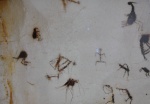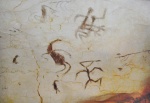Cuevas del Pomier, Dominican Republic
The Pomier Caves are located within a ragged limestone quarry a few miles north of San Cristobal in the Dominican Republic. When we visited in March 2012, it took us some time to find them, since there is no signage indicating the way to these 55 protected caves, nor that they represent the largest collection of ancient rock art in the Caribbean. Inside the caves the 6,000 pictographs and petroglyphs—the oldest of which date to about 2,000 years ago—were created over a period of 1,500 years by the Taino, Carib, and Igneri peoples. They had inhabited Hispaniola and the other Caribbean islands beginning about 8,000 years ago until their cultures were destroyed by European colonization, starting in 1492.
We visited the first three caves, guided by the local ranger. Inside the air was fresh enough to breathe easily, though it was humid, and in some spaces we saw bats darting around. It was absolutely dark and we could not have made any progress without the aid of our guide and a few flashlights. The floor of the cave started out wide, smooth, and flat, but as we went deeper into the caves systems, passing from one into the next, the going often got more challenging, the way suddenly littered with jagged rocks. Here we had to scramble up a jumble of small boulders. There we had to slide down a dry wash. Around us, the beams of our flashlights revealed deep passageways and cavernous chambers. Great stalactites clinging to the ceiling and walls, stalagmites spiking up from the floor, gave the interiors a lushly organic irregularity, like the inside of a monster's gullet. And as we walked, the guide pointed out the drawings on the walls around us. We were allowed to photograph only a single group, using our flashlights for illumination; we were permitted to use the camera flash only if it was not aimed at the drawings.
The drawings are mostly monochromatic line art, in "ink" made from a mixture of charcoal and animal fat, although there are also a few low relief etchings in some of the caves. They depict birds, lizards, human figures, and abstract designs. Many of the human figures appear to be holding long wands or pipes to their faces. Little is known about what the images actually depict, why they were painted, what they mean, or what purpose they served, since the cultures that created them were destroyed hundreds of years before the caves were rediscovered in the mid-nineteenth century. However, based on apparent similarities with surviving tribes in Venezuela, archaeologists speculate that the figures of people holding long sticks to their faces might be representations of individuals snorting cahoba, a hallucinogenic substance that is inhaled through long pipes. Shamans may have drawn on the cave walls whatever was revealed to them during their cahoba ritual.
It was spine-tingling to be sitting there, mere inches from this neolithic graffiti. Amid the disorienting contours of the caves, the hot, wet breath of the darkness, we confronted the remnants of a culture, ancient and alien, their indecipherable message from across the ages. Such moments hold enough human familiarity and open mystery that it's almost possible to glimpse, from the corner of your eye, an unimagined range of the human experience. [—Usha Alexander, March 2012]
First cave entrance (more) |
Prehistoric etching |
Prehistoric painting |
Inside the first cave |
Pitch dark interior |
Lit up by camera flash |
||
Going inside second cave |
Coming out later |
||
 |
 |
 |
 |
 |
 |
||
 |
|||
 |
 |
 |
 |
 |
 |
 |
 |
 |
 |
 |
 |
 |
 |
 |
 |
Information (more) |
Sample paintings |
Sample paintings |
Path to the caves |
Designed in collaboration with Vitalect, Inc. All rights reserved. |





















